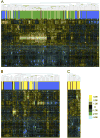Comparison of the American-European Consensus Group Sjogren's syndrome classification criteria to newly proposed American College of Rheumatology criteria in a large, carefully characterised sicca cohort
- PMID: 23968620
- PMCID: PMC3855629
- DOI: 10.1136/annrheumdis-2013-203845
Comparison of the American-European Consensus Group Sjogren's syndrome classification criteria to newly proposed American College of Rheumatology criteria in a large, carefully characterised sicca cohort
Abstract
Objective: To compare the performance of the American-European Consensus Group (AECG) and the newly proposed American College of Rheumatology (ACR) classification criteria for Sjögren's Syndrome (SS) in a well-characterised sicca cohort, given ongoing efforts to resolve discrepancies and weaknesses in the systems.
Methods: In a multidisciplinary clinic for the evaluation of sicca, we assessed features of salivary and lacrimal gland dysfunction and autoimmunity as defined by tests of both AECG and ACR criteria in 646 participants. Global gene expression profiles were compared in a subset of 180 participants.
Results: Application of the AECG and ACR criteria resulted in classification of 279 and 268 participants with SS, respectively. Both criteria were met by 244 participants (81%). In 26 of the 35 AECG+/ACR participants, the minor salivary gland biopsy focal score was ≥1 (74%), while nine had positive anti-Ro/La (26%). There were 24 AECG-/ACR+ who met ACR criteria mainly due to differences in the scoring of corneal staining. All patients with SS, regardless of classification, had similar gene expression profiles, which were distinct from the healthy controls.
Conclusions: The two sets of classification criteria yield concordant results in the majority of cases and gene expression profiling suggests that patients meeting either set of criteria are more similar to other SS participants than to healthy controls. Thus, there is no clear evidence for increased value of the new ACR criteria over the old AECG criteria from the clinical or biological perspective. It is our contention, supported by this report, that improvements in diagnostic acumen will require a more fundamental understanding of the pathogenic mechanisms than is at present available.
Keywords: Classification; Diagnosis; Sjögren's syndrome.
Conflict of interest statement
Figures


Comment in
-
The classification criteria for Sjögren syndrome: issues for their improvement from the study of a large Italian cohort of patients.Ann Rheum Dis. 2014 Jul;73(7):e35. doi: 10.1136/annrheumdis-2013-205076. Epub 2014 Jan 9. Ann Rheum Dis. 2014. PMID: 24406544 No abstract available.
References
-
- Helmick CG, Felson DT, Lawrence RC, et al. National Arthritis Data Workgroup. Estimates of the prevalence of arthritis and other rheumatic conditions in the United States. Part I Arthritis Rheum. 2008;58:15–25. - PubMed
-
- Gøransson LG, Haldorsen K, Brun JG, Harboe E, Jonsson MV, Skarstein K, Time K, Omdal R. The point prevalence of clinically relevant primary Sjögren's syndrome in two Norwegian counties. Scand J Rheumatol. 2011;40:221–4. - PubMed
-
- Fox RI. Sjögren's syndrome. Lancet. 2005;366:321–31. - PubMed
-
- Amador-Patarroyo MJ, Arbelaez JG, Mantilla RD, et al. Sjögren's syndrome at the crossroad of polyautoimmunity. J Autoimmun. 2012;39:199–205. - PubMed
-
- Daniels TE. Labial salivary gland biopsy in Sjögren's syndrome Assessment as a diagnostic criterion in 362 suspected cases. Arthritis Rheum. 1984;27:147–56. - PubMed
Publication types
MeSH terms
Grants and funding
LinkOut - more resources
Full Text Sources
Other Literature Sources
Medical
Molecular Biology Databases
Research Materials
Miscellaneous

